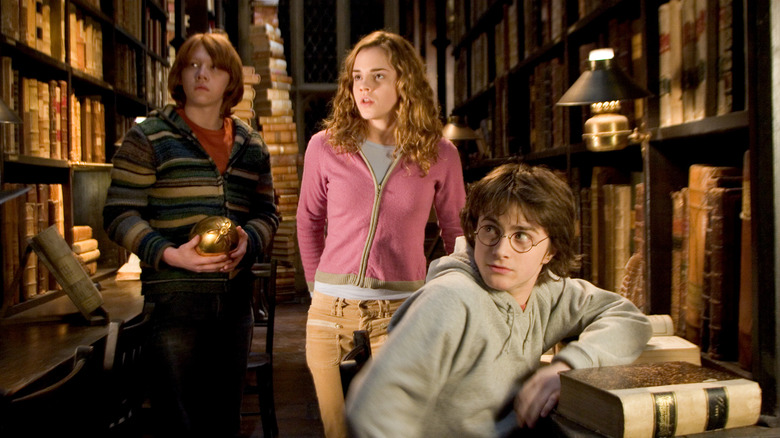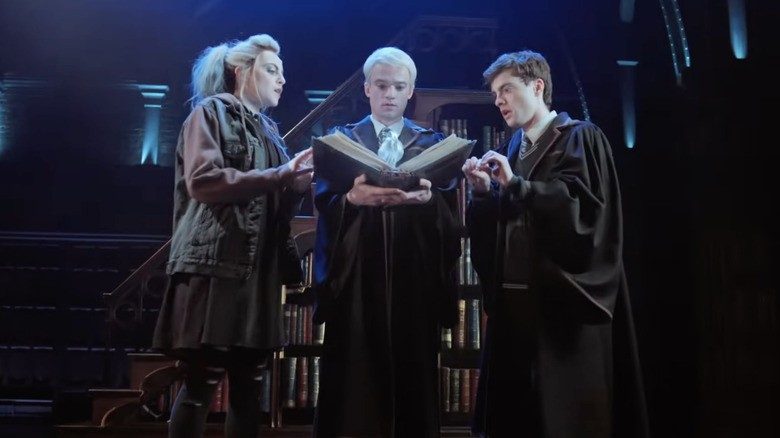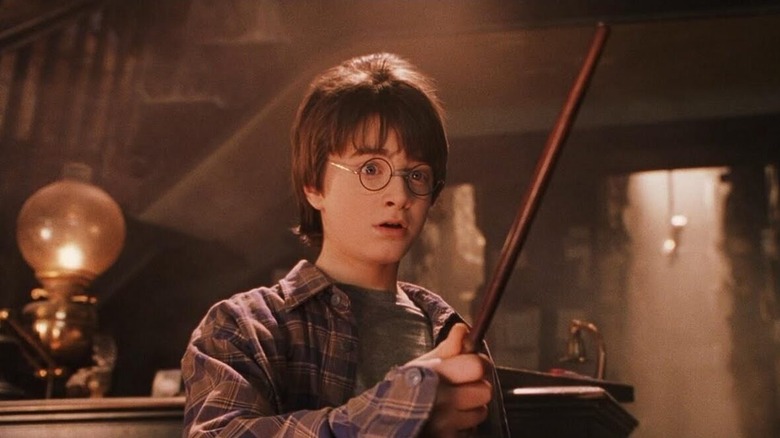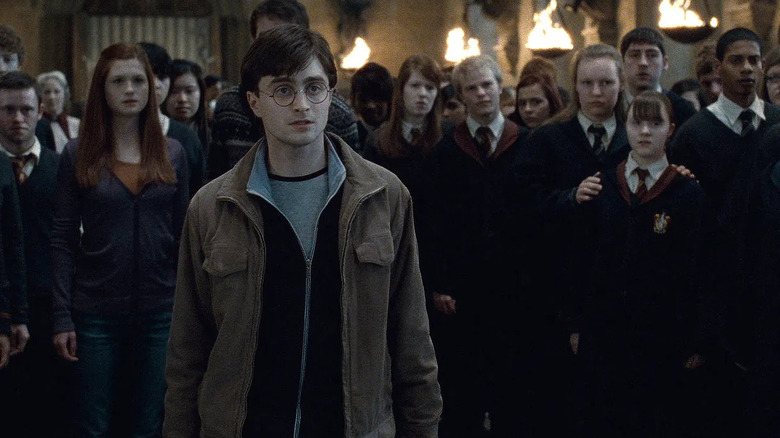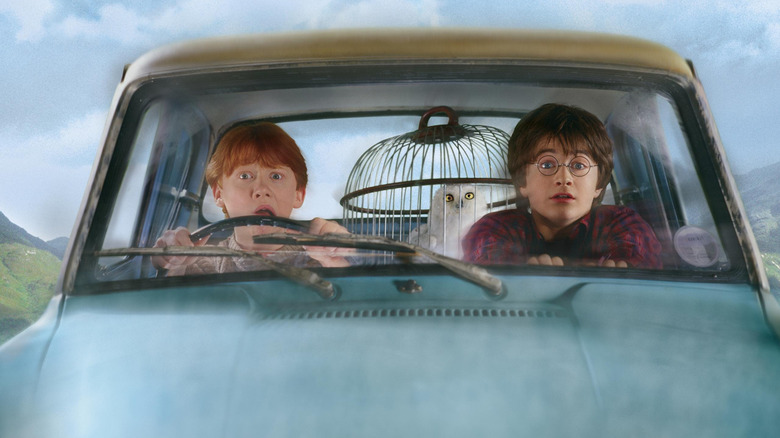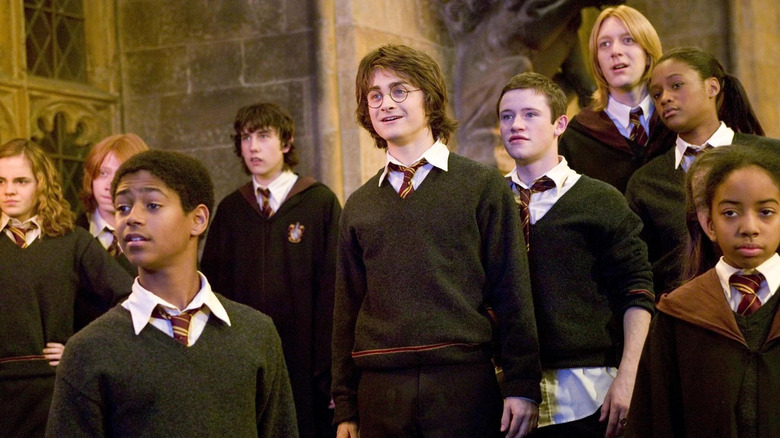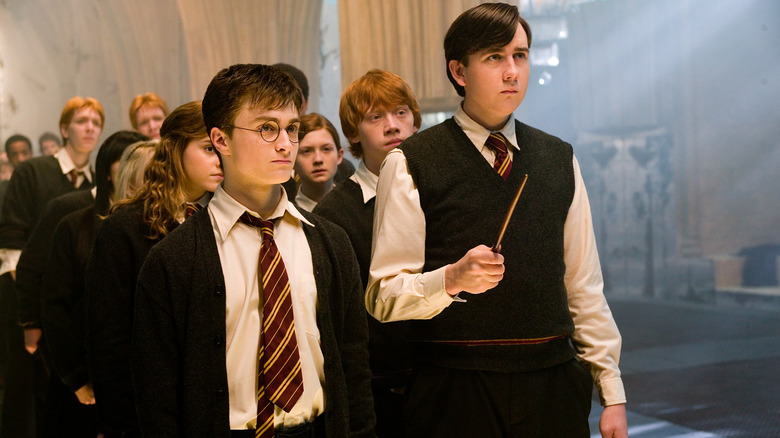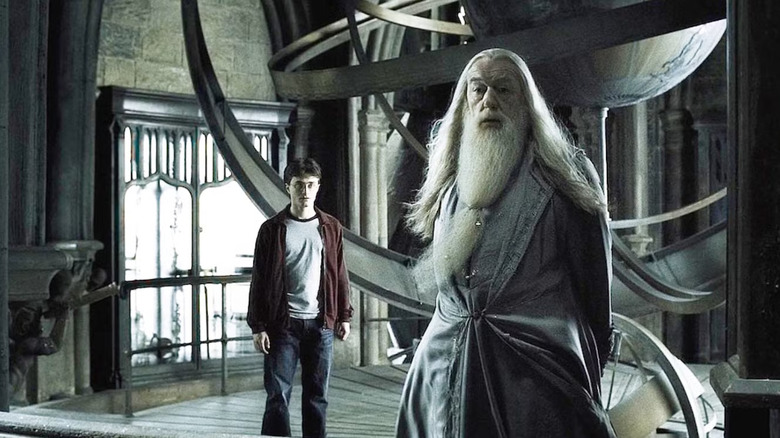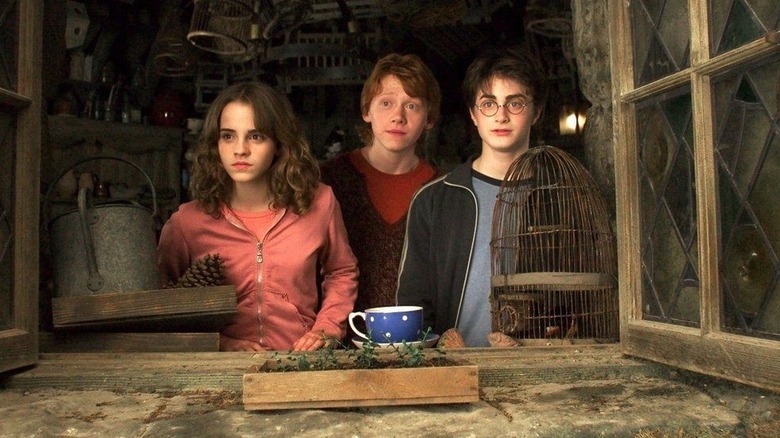All 8 Harry Potter Books Ranked (Including The Cursed Child)
Not every "Harry Potter" book is created equal. The series of fantasy novels designed for young adults — but enjoyed by adults throughout the world — first hit shelves in 1997 with "Harry Potter and the Philosopher's Stone" (subtitled "The Sorcerer's Stone" if you're in the United States), and after two sequels titled "The Chamber of Secrets" and "The Prisoner of Azkaban," the series was officially a sensation.
So what qualifies me, a humble /Film writer, to rank the "Harry Potter" books from worst to best? I was a kid when those books first came out, and to say they became my favorite books is an understatement; they basically became my entire personality. I've read and re-read the entire series too many times to count. I went to the Leavesden studio tour at the Warner Bros. lot back in 2014, got several of the books at midnight (R.I.P., Borders), saw the final two films at midnight screenings, was a Pottermore beta tester, and have a "Harry Potter" tattoo (it's of the three small stars used in the corner of each page of the American editions). Though my love for the series has been affected by author Joanne "J.K." Rowling's abject cruelty towards marginalized transgender women — and I suspect I'm far from alone when it comes to that — the "Harry Potter" books are still incredibly special to me, and despite their contradictions, I still love them.
Anyway, let's rank them! Here are all eight "Harry Potter" books, excluding things like "Fantastic Beasts and Where to Find Them" and "Quidditch Through the Ages," ranked — and last place probably won't come as a huge surprise. (Also, these are all pretty old and well-known, but just in case, spoilers ahead — and in terms of the films, no actors will be listed here, since these are separate entities!)
8. Harry Potter and the Cursed Child
Two things can be true at once. "Harry Potter and the Cursed Child," a sequel to the original franchise, is a gorgeously produced and brilliantly crafted stage play that uses practical magic to excellent effect. It's also a horrible script. The book version of "Cursed Child" came out on July 31, 2016, coinciding with the two-part play's premiere in London's West End — the American production on Broadway didn't premiere until 2018 — and for pretty much any "Harry Potter" fan who read the script before seeing the show, which I'd wager is most of them, it was an enormous disappointment. In broad strokes, the plot focuses on Harry Potter and Draco Malfoy's kids, Albus and Scorpius, who both end up in Slytherin when they arrive at Hogwarts, and who band together to right perceived wrongs using a Time-Turner.
Unfortunately, the entire thing with the Time-Turner — wherein Albus and Scorpius try to save the life of Harry's murdered Hogwarts classmate Cedric Diggory — feels like Joanne Rowling's attempt to respond to bad-faith takes from "Harry Potter" detractors that the Time-Turners should have been used to solve every single problem in the series.
This would, frankly, be annoying and bad enough, but then we've also got a character named Delphi, who claims to be a distant Diggory relative but turns out to be — no, seriously — the secret love child of Lord Voldemort and his most loyal Death Eater, Bellatrix Lestrange. (Sorry to Bellatrix's husband Rodolphus, I guess?!) Again, even though I was lucky enough to see "Cursed Child" in person and was blown away by a lot of the literal magic tricks they performed on stage — I still can't quite figure out how they did the optical illusion that happens in the theater whenever the Time-Turner gets used — that doesn't fix the fact that the book is infuriatingly bad.
7. Harry Potter and the Sorcerer's Stone
Now that "Cursed Child" is out of the way, we can get to the good stuff. "Harry Potter and the Sorcerer's Stone" (I'll be using the American title throughout) is not a bad book by any means, but it's the installment in the "Harry Potter" book series most obviously geared towards children, which means it doesn't age quite as well as some of the franchise's later entries when you go back to reread it. Still, "Sorcerer's Stone" is a pretty thrilling introduction to the wizarding world and Harry Potter himself, who we meet first as an infant — after his parents are killed by Lord Voldemort and he's rescued from the wreckage of their home, leaving wizards and witches around the world to try and figure out how he survived at all — and then again just before his 11th birthday.
As that specific birthday approaches, Harry, who lives with his awful non-magical Muggle aunt and uncle Vernon and Petunia Dursley and their odious son Dudley, starts getting mysterious missives delivered by owls, only to discover that he's a wizard and is enrolled at Hogwarts.
Harry arrives at school, finds two best friends — Ron Weasley and Hermione Granger — and settles in somewhat nicely until, as it so often does at Hogwarts, disaster strikes. Not only does the trio learn that the magical Sorcerer's Stone, the key to eternal life, is hidden within the school, but they also learn that someone is trying to steal it (and obviously, that someone is Voldemort). This marks Harry's first "reunion" with his magical nemesis in the series, and between the challenges surrounding the stone and the establishment of Harry's core friendships and life at Hogwarts, so it's vital — even if it's not the series' best.
6. Harry Potter and the Deathly Hallows
Sorry to "Harry Potter and the Deathly Hallows," the last book in the original series, which was adapted into two movies. Again, it's not bad, but not quite as good as the rest of the books, and it's saddled with a dreadful epilogue. (Put a pin in that.) The book kicks off with Harry, Ron, and Hermione preparing to abandon their schooling at Hogwarts and go out into the world to look for Voldemort's Horcruxes, magical artifacts that contain pieces of his soul and thus prevent him from being killed while they exist. After attending the wedding of Ron's elder brother at the Weasley family home, only to be attacked by Dark forces, the trio goes on the run and continues Horcrux hunting, searching for cups, diadems, and other objects that contain Voldemort's soul fragments.
We all basically know how "Deathly Hallows" goes. A lot of people die — including Fred Weasley, twin of George, which feels particularly cruel — and Harry learns from the seemingly evil Potions master Severus Snape's dying memories that he himself is a Horcrux and needs to sacrifice himself to bring down the Dark Lord. He does and is able to return to the world of the living to finally take down Voldemort, finally bringing peace to the wizarding world ... and then we get the godawful epilogue. Not only is the whole thing just awkward, clunky wish fulfillment — Harry and Ron's sister Ginny are married, as are Ron and Hermione — but we learn that Harry saddled his second kid with the name Albus Severus, which is just mean.
5. Harry Potter and the Chamber of Secrets
Similar to "Sorcerer's Stone," "Harry Potter and the Chamber of Secrets" is definitely meant to be for younger audiences — which also means it doesn't always provide the best experience when you revisit it in a reread. With that said, "Chamber of Secrets" is a legitimately awesome murder mystery for kids and adults alike. Before he returns to Hogwarts for his second year, Harry is antagonized by a random house-elf named Dobby who insists that Harry can't return to school because he's in danger, and the lengths Dobby goes to in order to sabotage Harry's return are ... troubling and even dangerous. After Harry and Ron steal the Weasley family's flying car to get to school (because Dobby prevented them from getting through Platform 9¾) and get punished for that, things take an even worse turn when students start getting Petrified by an unknown source, leading to rampant rumors that a monster within the school's mysterious Chamber of Secrets is running loose in the school.
Naturally, Harry is the one who solves the mystery. As it turns out, Lucius Malfoy, a former Death Eater, slipped an old diary of Voldemort's into Ginny Weasley's belongings before her first year began, and the spirit of a young Voldemort possessed her and opened the Chamber. (Also, the monster is roaming Hogwarts, and it's a basilisk, which kills people with just a look; thankfully, nobody looks directly at it, and the Petrified parties are ultimately revived.) "Chamber of Secrets" is extremely fun, but it's not quite as clever or layered as some of the books that follow.
4. Harry Potter and the Goblet of Fire
Harry's fourth year, which we experience in "Harry Potter and the Goblet of Fire," is where the entire series takes a dark turn ... and it's better for it. The entirety of Hogwarts is abuzz during this school year thanks to the fact that the school is hosting the Triwizard Tournament, which took a lengthy break after students died performing the tasks — but thanks to new safety protocols, Hogwarts is joining forces with the French wizarding school Beauxbatons and the Bulgarian magical academy Durmstrang to host it once again. Even though the school champions are chosen thanks to an objective magical object called the Goblet of Fire that shouldn't allow students under the age of 17 to enter, I'm sure you can see where this is going in that Harry is somehow chosen as a fourth champion (alongside Cedric Diggory from the Hogwarts house Hufflepuff, Fleur Delacour for Beauxbatons, and Quidditch star Viktor Krum for Durmstrang).
It's ultimately revealed that Harry's participation in the tournament is an elaborate plot concocted by Voldemort himself and one of his most loyal lieutenants, Bartemius Crouch Jr., a Death Eater many believed died in the wizard prison Azkaban. At the end of the third and final Triwizard task, apparent winners Harry and Cedric agree to take the Triwizard Cup together, only to be transported to a graveyard and watch Voldemort return to full power ... and Cedric, the "spare," is murdered in the process. Cedric's senseless and unnecessary murder is the darkest thing in the "Harry Potter" timeline up until this point, and it's remarkably gutting — plus, it sets up real stakes for the trials and tribulations to come in the series.
3. Harry Potter and the Order of the Phoenix
After the events of "Goblet of Fire," we catch up with a deeply traumatized Harry in "Order of the Phoenix" as he waits out yet another dreadful summer with the Dursleys before he can go back to Hogwarts. When a dementor — a foul creature used to guard Azkaban — appears in the Muggle suburb where Harry resides with the Dursleys and he has to fight it off, saving Dudley's life in the process, he realizes things are seriously amiss. Then, when he's forced to stand trial for defending himself, Harry meets the awful Ministry of Magic stooge Dolores Umbridge, who ultimately infiltrates Hogwarts as a plant to control headmaster Albus Dumbledore's approach to teaching (and what he tells his students).
Harry, who's now the center of a smear campaign orchestrated by the Ministry that denies Voldemort's return, ends up rebelling against the school he loves after Umbridge takes full control. Alongside Ron and Hermione, he forms a student group that they dub Dumbledore's Army — a response to Umbridge's new decree that students won't learn any actual defensive spells in their mandatory Defense Against the Dark Arts classes — and train in secret, dodging Umbridge's overreach as they do so.
This is all made much more complicated by Harry's strange visions tied to the now-powerful Voldemort, which the Dark Lord uses against him by planting a false vision of Harry's beloved godfather, Sirius Black, trapped within the Ministry's Department of Mysteries. When Harry goes to rescue him — alongside Ron, Hermione, Ginny, Luna Lovegood, and Neville Longbottom — he discovers the ruse and fights off Death Eaters over a prophecy Voldemort is desperate to obtain, but the result is that the real Sirius comes to his rescue and is killed. At the very end of the book, Dumbledore tells Harry about the prophecy, which centers on him and Voldemort and states that "neither can live while the other survives" — setting up the main conflict for the final two installments.
2. Harry Potter and the Half-Blood Prince
"Harry Potter and the Half-Blood Prince" is probably best remembered as the book where Severus Snape kills Albus Dumbledore, and that does happen. Still, there's a lot more to it than that — and it came very close to taking the top spot on this list. After the events of "Order of the Phoenix," Harry and Dumbledore team up to explore collected memories about Voldemort's past and his goals of creating those Horcruxes, and even though the film adaptation cuts all but two of these memories, the book leans into this unconventional way to explore the villain's backstory and features a whole bunch of them. Not only are these backstories fascinating looks at Voldemort's psyche, but they do a great job of fleshing out the entire wizarding world, introducing us to witches, wizards, and Muggles who contributed to Voldemort's descent.
Alongside that, Snape finally gets his dream job — transitioning from Potions master to Defense Against the Dark Arts teacher — and makes Harry's life incredibly difficult, though Harry succeeds under the "new" Potions master Horace Slughorn, who taught at Hogwarts decades prior. How does Harry, a pretty average Potions student, succeed specifically? Well, his Potions textbook used to belong to the "Half-Blood Prince," who turns out to be incredibly gifted at potion-making and left notes and spells in the margins ... and also, it's revealed, is Snape himself. While all of this is going on, Draco Malfoy, a newly anointed teenage Death Eater, is quietly making it possible for more of the Dark Lord's acolytes to break into the school and kill Dumbledore — and also, Harry falls head over heels in love with Ginny. "Half-Blood Prince" is a great penultimate story, but it narrowly misses out on the top spot here.
1. Harry Potter and the Prisoner of Azkaban
"Harry Potter and the Prisoner of Azkaban" usually wins in voter polls for the best movie in the franchise — and it's also the best book. Even though "Prisoner of Azkaban," like "Sorcerer's Stone" and "Chamber of Secrets," skews a little younger, its story is incredibly engrossing, and its third-act twist is far and away the best twist in the entire franchise. Before his third year at Hogwarts, Harry learns that a famous wizard murderer, Sirius Black (yes, that's his godfather, let me explain!), recently broke out of Azkaban and is on the run; not only that, but it sure seems like Sirius is hunting Harry specifically. As Harry uncovers more about Sirius' past, he learns that the convict was his father's best friend and is his godfather, complicating the entire situation ... and driving Harry to seek revenge against Sirius.
When Sirius, Harry, Ron, Hermione, and that year's Defense Against the Dark Arts professor Remus Lupin — who was also a school friend of Sirius and James Potter alongside their fourth buddy Peter Pettigrew — end up in Hogsmeade's supposedly haunting Shrieking Shack, our main trio all learn the truth. Sirius is innocent and was framed by Peter. Both of them are Animagi, meaning they can change into animals at will, and James also learned to do this while they were all at school (Sirius becomes a dog, Peter becomes a rat, and James becomes a stag, which they did to keep Remus, a werewolf, company during full moons). Also, that pet rat named Scabbers that Ron's been toting around since the first book? That was Peter the entire time!!! This twist, along with the introduction of the Marauder's Map (created by the four friends) and a genuinely interesting deployment of the Time-Turner that saves Sirius' life and allows him to evade the Ministry, is what makes "Prisoner of Azkaban" the best book in the "Harry Potter" series, without question.
